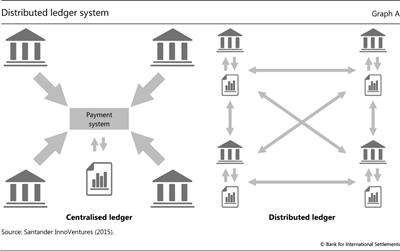What is distributed ledger technology?
(Extract from page 58 of BIS Quarterly Review, September 2017)
Distributed ledger technology (DLT) refers to the protocols and supporting infrastructure that allow computers in different locations to propose and validate transactions and update records in a synchronised way across a network. The idea of a distributed ledger - a common record of activity that is shared across computers in different locations - is not new. Such ledgers are used by organisations (eg supermarket chains) that have branches or offices across a given country or across countries. However, in a traditional distributed database, a system administrator typically performs the key functions that are necessary to maintain consistency across the multiple copies of the ledger. The simplest way to do this is for the system administrator to maintain a master copy of the ledger which is periodically updated and shared with all network participants.
By contrast, the new systems based on DLT, most notably Bitcoin and Ethereum, are designed to function without a trusted authority. Bitcoin maintains a distributed database in a decentralised way by using a consensus-based validation procedure and cryptographic signatures. In such systems, transactions are conducted in a peer-to-peer fashion and broadcast to the entire set of participants who work to validate them in batches known as "blocks". Since the ledger of activity is organised into separate but connected blocks, this type of DLT is often referred to as "blockchain technology".
The blockchain version of DLT has successfully powered Bitcoin for several years However, the system is not without drawbacks: it is costly to operate (preventing double-spending without the use of a trusted authority requires transaction validators (miners) to employ large amounts of computing power to complete "proof-of-work" computations); there is only probabilistic finality of settlement; and all transactions are public. These features are not suitable for many financial market applications. Current wholesale DLT payment applications have therefore abandoned the standard blockchain technology in favour of protocols that modify the consensus process in order to allow enhanced confidentiality and scalability. Examples of protocols currently being tested by central banks include Corda and Hyperledger Fabric. Corda replaces blockchain with a "notary" architecture. The notary design utilises a trusted authority and allows consensus to be reached on an individual transaction basis, rather than in blocks, with limited information-sharing.
there is only probabilistic finality of settlement; and all transactions are public. These features are not suitable for many financial market applications. Current wholesale DLT payment applications have therefore abandoned the standard blockchain technology in favour of protocols that modify the consensus process in order to allow enhanced confidentiality and scalability. Examples of protocols currently being tested by central banks include Corda and Hyperledger Fabric. Corda replaces blockchain with a "notary" architecture. The notary design utilises a trusted authority and allows consensus to be reached on an individual transaction basis, rather than in blocks, with limited information-sharing.
 See also Chapman et al (2017), CPMI (2015) and Benos et al (2017).
See also Chapman et al (2017), CPMI (2015) and Benos et al (2017). The amount of energy currently being used by Bitcoin miners is equal to the energy consumption of Lebanon and Cuba (see http://digiconomist.net/bitcoin-energy-consumption). For a detailed description of proof-of-work, see https://en.bitcoin.it/wiki/Proof_of_work.
The amount of energy currently being used by Bitcoin miners is equal to the energy consumption of Lebanon and Cuba (see http://digiconomist.net/bitcoin-energy-consumption). For a detailed description of proof-of-work, see https://en.bitcoin.it/wiki/Proof_of_work.

